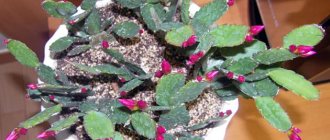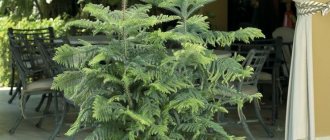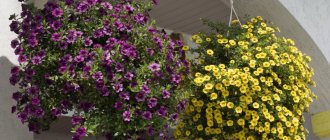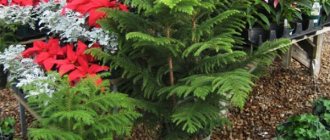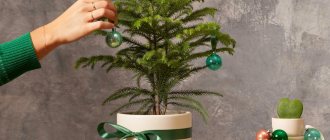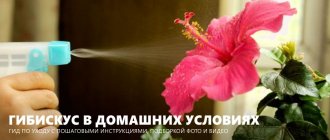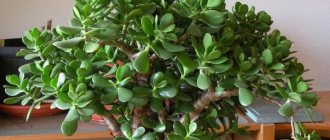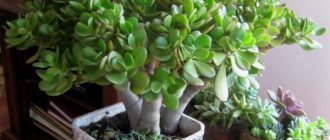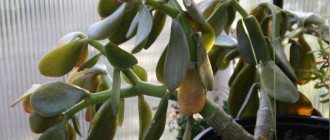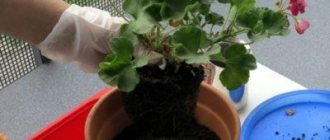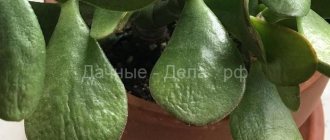Yes, yes, monkey tree, tree of happiness, crassula or crassula - all these are the names of the flower that is most often called the money tree. It is called money because the leaves resemble large coins. It is believed that the presence of this flower attracts cash flows into the house and improves the financial condition of its inhabitants. According to popular belief, in order for a flower to “work” for you, you must follow several rules.
Money Tree. The illustration for the article is used under the standard license ©dachnyedela.ru
Monkey tree, Crassula or Crassula - what kind of flower is it?
The popular name - money tree - was obtained due to the external similarity of the leaves of the flower to coins. The monkey tree is most often called the plant in Southern countries. Crassula is a Russian name that appeared due to its fleshy and thick leaves.
Well maintained money tree
The height of a bush or tree can reach even 1 meter. The leaf plates of the flower are collected in so-called rosettes, in which moisture condensation occurs. Thanks to thick leaves covered with a waxy coating, the tree is reliably protected from drying out.
Popular types
About 20 species of monkey trees are found in nature, but only a few, the most compact specimens are used for indoor cultivation.
Araucaria variegated. An unpretentious plant with a height of only 50-65 cm. On an erect trunk, also covered with needles, there are horizontal long branches. All vegetation is colored bright green. On each branch there are several more gradually shortening lateral processes. On a young tree, the shoots are densely dotted with needle-shaped bright green needles. Their length is 1-2 cm and width is 1 mm. Over the years, the needles become triangular, similar to adjacent green scales. The length of the scales is 8-10 mm with a width of 2-4 mm.
Araucaria varifolia
Brazilian monkey tree (Araucaria angustifolia). A taller plant that can also be grown at home. Its height can reach 3-4 m. It grows in the south of Brazil. At the top of the long stem there are several whorled branches. In appearance, the tree resembles a palm tree. The entire crown is grouped at the top in the shape of an umbrella. Lanceolate dark green scales end in a sharp spike. The length of the needles is 3-6 cm, with a width of 5 mm. On fertile branches the needles are located much denser. The trees are dioecious, leathery cones reach 20 cm in diameter.
Brazilian monkey tree
Araucaria Chilean. The plant is a tall (up to 60 m), erect tree. This high-altitude monkey tree is adapted to cold weather and can withstand short frosts down to -20 °C. The bark of even an adult plant is green. The surface of the stem is covered with many scars left by fallen branches. Coniferous scales in the shape of a concave triangle, 3-4 cm long and 1-3 cm wide, are distributed in a spiral. Each leaf can remain on a branch for up to 15 years.
Araucaria chilean
Hanstein's monkey tree is becoming increasingly common in culture today. These small potted Christmas trees are very popular. This species is native to New Guinea, where it can grow up to 90 m in height. The top of the even trunk is dotted with whorls of branches. Coniferous scales or small needles are 6-12 cm long and 1.5-2 cm wide. They have a wider base and a pointed edge. Monoecious plants bear male flowers on thinner branches, and oval cones with a diameter of up to 25 cm are located on thicker shoots.
Hanstein's Monkey Tree
Money tree sheds leaves in summer or winter, is this normal?
In the summer, the fat plant can shed healthy leaves. This is caused by the natural need of the flower for reproduction.
Money tree diseases - why leaves fall off the money tree
Also, if the number of fallen leaves is not critical, then this may occur due to the natural renewal of the plant crown. If new leaves appear in place of fallen leaves, then do not worry.
In winter, daylight hours decrease and this causes the loss of more leaves. You can help the plant preserve its green mass by organizing additional lighting with special phytolamps.
For reference! For normal flower development, it is necessary to extend the daylight hours to 10-12 hours.
Chemical composition
The composition of catalpa has not been well studied. The bark contains tanning elements and special resins, which give it useful qualities. Experts found the presence of glycosides in the leaves.
The seeds also contain about 30% oil rich in eleostearic acid. All these substances make the composition of the culture quite rich, and it can have a complex effect on the body when used for therapeutic purposes.
1
3
Reasons why a money tree may shed its leaves
Why do clerodendrum leaves turn yellow and fall off?
The main reason why money tree leaves fall is failure to comply with the conditions for growing and caring for the plant.
Illiterate watering regime
Under natural conditions, Crassula grows in the driest regions. An individual feature of a flower is its ability to accumulate and store moisture in its leaf blades for a long time. Domestic representatives are also endowed with this quality. That is why you should be careful about the watering regime.
Flower overflow
It is strictly forbidden to allow the soil to become waterlogged - this will inevitably lead to rotting of the root system. The next stage is the fall of leaves.
Important! The succulent needs to be watered once a week in spring and summer, and much less frequently in autumn and winter - once a month.
The only way to help the plant is through emergency transplantation and removal of damaged parts of the root. For this purpose, the root system is completely cleared of contaminated soil and the tree is transplanted into a new substrate.
If timely moistening is not carried out and the earthen lump dries out greatly, then the leaves will first wither and wrinkle, and then begin to fall off. Urgent adoption of rehabilitation measures will help save the situation. To do this, place the flower pot in a container with water for 40-50 minutes. This procedure will allow the soil to be sufficiently saturated with the necessary moisture.
Insufficient soil moisture
Advice! The absence of water in the pan will not allow the water to stagnate and will not lead to waterlogging of the soil.
Exposure to direct sunlight
The classic representative of the money tree is not too demanding on the level of illumination. The plant feels great both in the shade and in a sunny place. But the main thing to remember is that, as for any other species, the light must be diffused. Direct sunlight can not only scorch the leaves, but also cause the entire green mass to fall off.
At the first sign of burns, the leaves begin to turn yellow and disappear. Also, if you do not properly care for the fat plant, the branches will stretch and weaken.
Fallen leaves of a plant
Too much fertilizer
Due to the fact that the plant grows in poor soils in its natural habitat, the money tree will begin to shed leaves only when the nutritional content of the soil is as low as possible. With the appearance of the first signs of micronutrient deficiency, it is necessary to urgently feed.
Fertilizers are applied from late spring to September. To do this, use liquid fertilizers designed for cacti or succulents.
Important! Any special preparations must be diluted according to the instructions. Exceeding the concentration can lead not only to damage, but also to the death of the flower.
You need to feed the succulent once every 14 days. Supporting preparations are applied to pre-moistened soil. Such feeding rules are due to better absorption and preservation of the root system.
Natural soil depletion often occurs. To balance the level of minerals, the tree is transplanted into a new substrate. The mixture is prepared from the following components:
- peat (1 part),
- humus (2 parts),
- nutrient soil (2 parts),
- river sand (2 parts).
By adding charcoal to the resulting soil, you can not only enrich this soil mixture, but also carry out natural disinfection of the substrate.
Incorrect water temperature for irrigation
Using regular tap water can also cause leaves to fall off. For irrigation, it is recommended to use only water at room temperature that has been standing for 2-3 days. It is not allowed to use either cold or too warm. This can cause leaf fall and disruption of necessary metabolic processes.
For information! If the leaves have already begun to fall, then spraying with warm water will help preserve the remaining green mass. When carrying out this procedure, do not allow liquid to get into the pot.
Experienced gardeners use rain or melt water for irrigation.
Temperature changes
In winter, when heating devices are on, the plant also does not feel well. Leaves may not only wither, but even fall off. To help the plant, it is necessary to regularly do the sprinkling procedure.
Streams of dry hot air harm not only all indoor flowers, but also humans. Air humidification can be carried out with a conventional spray gun or using special steam generators.
The flower grows best at a constant temperature, which is +25..+27 degrees during the growing season and +15 during the dormant period. When temperatures drop, the succulent begins to abruptly shed its leaves and lose its decorative effect.
Also, the flower can shed its leaves due to sudden temperature changes. If you move a plant from a warm room to a cold one, this will certainly lead to stress, and may even provoke disease in the succulent.
On a note! If the root system of a tree is frozen, then it will no longer be possible to save it. The only way out is to use cuttings of a “dying” flower to propagate and grow a new one.
Sometimes you can observe the loss of leaves in Crassula before the appearance of new young shoots.
Seeds
It is recommended to sow fresh, that is, no later than 2 months from the date of collection. Older seed material is no longer germinating. It is permissible to plant one or two seeds per pot. It is better to make several landings, since not everyone will ascend. Plant the seeds buried a couple of centimeters in moist soil. Take either sand-leaf or sand-peat mixture. Add some charcoal. The planting is kept at a temperature not exceeding +20 degrees Celsius. The soil is regularly sprayed. If the seeds are fresh, then shoots appear in 2-8 weeks. No transplanting or picking is required. A seedling needs a new pot only when the roots fill the space of the old container.
Can leaves turn yellow and fall off due to diseases and pests?
Why do dracaena leaves turn yellow and fall off?
The leaves of the Crassula or Money Tree fall off when they are sick or damaged by insects.
Fungal infection
Most often, leaves begin to fall due to infection of the crassula flower with all kinds of fungal infections.
The most dangerous are:
- Root rot. At the first stage of infection, the leaves begin to dry out and turn yellow. Then the entire root of the flower is affected and the tree dies. The situation can be saved if you carry out an emergency transplant and treat the root system with charcoal.
- Stem rot. Rotting begins gradually, the leaves are the first to be affected, then the branches and trunk. All damaged areas must be pruned: roots, stems, shoots. Living tissue can later take root and grow into a real tree.
- If the fungus has attacked only part of the branches, then emergency pruning of the damaged shoots will help save the flower from death.
Important! All cuts and cuts must be treated with crushed charcoal or antifungal pesticides.
The most dangerous pests are:
- The spider mite not only affects the flower, it is because of it that the plant begins to shed its leaves.
- The most dangerous pest is the common scale insect. The only way to escape is to remove all insects manually.
- Mealybugs can quickly infect and destroy not only the money tree, but also all nearby plants. The affected areas become covered with a white sticky coating.
Destructive root rot
Most often used for protection and fight:
- insecticides - preparations for killing insects;
- acaricides - products that have a more limited range of effects, are mostly used to combat ticks;
- mixed species are used for preventive measures.
Description of the plant
The monkey tree as a houseplant can reach a height of 1.5 m, although in nature there are specimens up to 50 m high. It has a developed root system that goes deep. The annual growth in the most favorable conditions does not exceed 10-15 cm.
Young shoots, including the stem, are covered with bright green bark. As they age, the branches become woody and turn brown. The lateral processes are located horizontally or have a drooping shape. The branches form tiers from the very base of the stem. Gradually the plant sheds its lower shoots and the trunk becomes bare. The branches themselves, covered with short, hard needles, are cylindrical in shape and resemble the tail of an animal. This similarity is especially noticeable in mature massive plants. Therefore, another name for the tree is monkey tails.
The needles resemble hard sessile leaves. Narrow triangular or oblong spines are light green with a bluish tint. Upon closer inspection, you will notice that the needles are arranged in a spiral. They sit very firmly on the branches and fall off only with them. The needles evaporate essential oils and phytoncides. They improve the composition of the air and also help fight harmful microorganisms.
Most monkey trees are dioecious. Their flowering occurs after full maturity, at approximately 40-50 years. On lower male plants, elongated flowers with many anthers bloom. Their length can reach 20-25 cm. Large oblong cones covered with green skin ripen on female trees. The diameter of the cones is about 35 cm. They contain edible pine nuts, similar to pine nuts.
What to do, how to help the money tree
It is easy to see that there are a huge number of reasons why the leaves of the fat plant fall off. But they all come down to an irresponsible attitude, which is caused by improper care and failure to comply with basic growing rules.
Falling and wilting of leaves of the species
To save the flower, the causes of this negative phenomenon must be urgently eliminated. Very often it is enough to simply adjust the growing conditions of the succulent. And after a short period of time, new shoots will appear on the money tree and foliage will grow.
If leaf flying is a consequence of a disease, then you cannot do without the use of special means. The main thing is timely identification of the cause and treatment of Crassula with suitable drugs.
It should be remembered that, despite the completely unpretentious nature of the plant, it still requires at least minimal attention. Following basic and very simple rules of care will allow you to admire the decorative qualities of the money tree for many years.
Money tree - an element of room decor
And if you show a little effort and imagination, the succulent can be turned into a real work of art.
Beneficial features
It is generally accepted that the plant brings financial success and prosperity to its owner. That’s why it came to be called the money tree. Crassula has other names: tree of luck, monkey tree.
For its healing properties, the money flower is sometimes called a living tree.
Many people know that the fat woman has positive energy. But not everyone knows that this money tree has healing properties and is a filter plant. The phytoncides secreted by Crassula have pronounced antiviral, antibacterial and antifungal properties and disinfect indoor air.
Crassula juice is used to treat:
- herpes, insect bites, cuts, abscesses, bruises (as lotions);
- sore throats, gum inflammation (in the form of rinses);
- arthritis, other joint diseases (rubbing before bedtime).
Parts of the plant are strictly forbidden to be taken orally as medicine - they contain large amounts of arsenic.
Photo
See more photos of the fat woman:
The monkey tree plant, monkey riddle or simply araucaria is very beautiful and unusual. This is the oldest representative of coniferous trees, which can be found on the rocks of South America, Australia or New Zealand. The monkey tree belongs to the Araucariaceae family. In the natural environment, giant trees predominate, but miniature specimens are usually used in culture. In the photo, the monkey tree resembles a small Christmas tree that can be decorated for the New Year. It also looks charming in a room all year round.
Main varieties
There are 21 species of Araucaria found in the wild, but only 2 of them can be found in America, the rest in Australia, the Norfolk Islands, New Guinea and New Caledonia. No more than 4 varieties are suitable for breeding at home, greenhouses and offices, which do not reach enormous sizes and tolerate indoor growing conditions:
- Variegated araucaria (indoor spruce) . A small tree with a pyramidal crown, green modified leaves in the form of needles. The trunk is covered with dark brown bark, on which there are thin light scales. The tree's needles are soft, tightly pressed to each other, and densely distributed on the branches.
- Narrow-leaved araucaria (Brazilian) . A tall indoor specimen that can reach a height of more than 3 m. The leaves are triangular, short, soft, light green. They are densely located on the shoots. A distinctive feature of this variety is that the soft shoots are directed downwards.
- Chilean araucaria. The hard leaves are triangular in shape with a pointed end and a flared base. The branches are densely covered with thin needles. The stems are dense, tall, with hard lignification. Wood of this variety is highly valued in furniture production. Edible seeds are formed in the cone fruits. This variety is the most frost-resistant.
- Araucaria Cooka. A rare variety even in natural conditions. The branches grow almost perpendicular to the rigid, tall trunk. It is distinguished by long, up to 10 cm, cones that are covered with soft green bristles.
Variegated
Narrow-leaved
Chilean
Kuka
Columnar araucaria variety is grown only in open ground or in greenhouses, since the height of the trunk is much higher than that of decorative forms. Thick short branches are located at an angle of 90 degrees to the thick massive trunk, the crown is pyramidal.
Transfer rules
It is not recommended to transplant too often. As long as the roots have not filled all the free space in the pot, the tree will develop perfectly without outside interference. Before replanting the monkey tree, you need to dry the soil a little. The procedure is planned for early spring. You should prepare a wide pot with holes in the bottom. First, pour out shards or brick chips.
The soil for planting should include the following components:
- sand;
- turf land;
- peat;
- leaf soil;
- charcoal.
It is important to be extremely careful with the rhizome and use the method of transferring the earthen clod. The old soil should be preserved as much as possible.
Reproduction methods
Araucaria can be propagated at home in two ways: cuttings and seeds.
Cuttings
Indoor spruce is most easily propagated by cuttings. The best time for this procedure is August, but it can be performed until June of the next season. It is optimal to take cuttings for planting at a time when growth slows down and the plant enters the dormant phase. If you do this later or earlier, the cutting will be thin, will not take root well, and the apical bud will produce new needles even after trimming the shoot.
Young and strong shoots are removed from the top of the tree. The branch should not be cut, but carefully unscrewed by hand along with the growing point (whorl), then treated with a root formation stimulator, placed in a container with moistened clean river sand or a mixture of peat and sand. The jar or glass with the shoot is covered with film or transparent glass, creating greenhouse conditions.
When cutting, it is important that the shoot itself and the soil in which it stands are always moist, but not wet. To do this, watering is done once a day, spraying - 3 times a day.
Cuttings take a long time to take root, at least 6 months. Then callus appears at the bottom of the shoot - a young root system. The shoots are planted in a mixture of soil for conifers and sand in a 1:1 ratio, and by the beginning of summer, together with a lump of earth, they are transferred into a permanent pot with a drainage layer and special soil for conifers. In the first two weeks, cover with film, then remove it completely. The first young branches on the plant appear a year after cutting the cuttings.
Seeds
This plant reproduces by seed, but at home this is practically impossible. Due to insufficient lighting in indoor conditions, there is no flowering (and fruits with seeds) on the tree.
Crassula in nature
It is represented by aquatic plants, creeping herbaceous species and tree-like shrubs. Mostly money trees grow in tropical latitudes
African continent.
are over 300 varieties of them in nature.
. There are herbaceous (these include ampelous and ground-blooded) and bushy forms, similar to branched trees. Some prefer a humid environment.
Take proper care of the monkey tree, and it will definitely bear fruit in the form of financial well-being.
